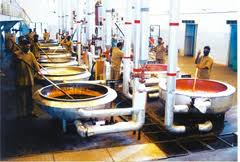Ayurveda in the modern world :
For a few centuries, the tradition of Ayurveda was dimmed due to the natural and human calamities and also by the invasion of foreign cultures into India. The sacred texts were either destroyed or stolen. During this period it became the second option for treatment used mostly by traditional spiritual practitioners and the poor. However there were many ‘Vaidyas’ or doctors in India who managed to preserve some of the knowledge available in these Holy Scriptures. Divine plants that sustain long life and good health are now being rediscovered.
|
|
 |
After independence, Ayurveda started to gain importance again and several schools have been established since then. Today there is a revival of the ancient culture and traditions inherent to Ayurveda, which is a true gift of the ancient civilization to the modern world. Even today Ayurvedic medicine maintains its holistic approach to health and treatment of diseases. The branches of modern Ayurveda include:
- Principles of preventive healthcare for the entire family (kulam svastyam kutumbakam).
- Treatment of addictions (sangakara chikitsa).
- Purification and rejuvenation treatments (panchakarma chikitsa).
- The Ayurvedic approach to diet and weight loss (sthaulya chikitsa)
- Musculoskeletal system treatments (vatavyadhi chikitsa).
- Promotion of self-healing and resistance to disease (svabhaavoparamavaada).
- Male and female infertility (vajikarana).
- Beauty and cosmetic treatments for men and women (saundarya sadhana).
According to some sources Up to 80% of people in India used to use some form of traditional medicines, a category which includes Ayurveda.
In 1970, the Indian Medical Central Council Act which aims to standardize qualifications for Ayurveda and provide accredited institutions for its study and research was passed by the Parliament of India. In India, over 100 colleges offer degrees in traditional Ayurvedic medicine. The Indian government supports research and teaching in Ayurveda through many channels at both the national and state levels, and helps institutionalize traditional medicine so that it can be studied in major towns and cities. The state-sponsored Central Council for Research in Ayurvedic Sciences (CCRAS) has been set up to research the subject. To fight bio piracy and unethical patents, the Government of India, in 2001, set up the Traditional Knowledge Digital Library as repository of 1200 formulations of various systems of Indian medicine, such as Ayurveda, Unani and Siddha.
Central Council of Indian Medicine (CCIM) a statutory body established in 1971, under Department of Ayurveda, Yoga and Naturopathy, Unani, Siddha and Homoeopathy (AYUSH), Ministry of Health and Family Welfare, Government of India, monitors higher education in Ayurveda. Many clinics in urban and rural areas are run by professionals who qualify from these institutes.
For Manufacturing: In 1964, manufacturing of Ayurvedic Medicine was brought under the scope of Drugs & Cosmetics Act, through an amendment enacted by the parliament. As a result, the government could exercise appropriated regulation over the manufacturing of Ayurvedic Medicine. This regulation helped the Industry of Ayurvedic Medicines to grow in a healthy environment.
The GMP (Good Manufacturing Practice) certification also played an important role to provide, quality standard as per the norms of World Health Organization in the field of Ayurveda Industries. Recently Govt. of India has laid down separate GMP requirements for Ayurvedic manufactures.
DHARMANI HEALTHCARE has fulfilled all the above norms and was awarded with GMP certificate also.

